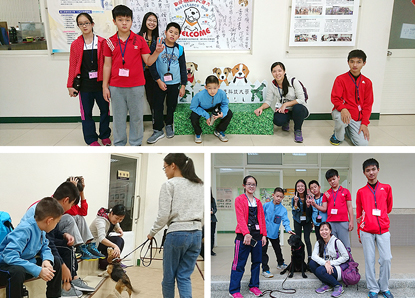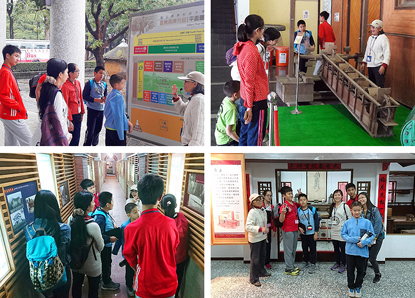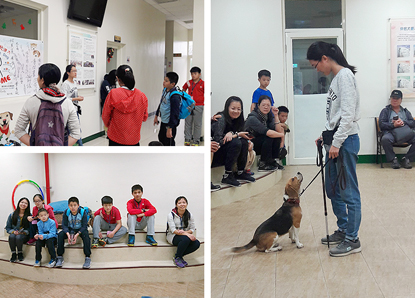Sketch of Archilife Study Tour, January 2018
|
2018年1月份見識之旅縮影  1月份見識之旅活動,於2018年1月6日由呂明澐小姐帶領5位祐生見習生,進行屏科大野生動物生命教育暨工作犬訓練之旅。活動開始之初,領隊呂明澐小姐提醒本次活動注意事項及觀察重點,先行建立見習生的背景知識。 1月份見識之旅活動,於2018年1月6日由呂明澐小姐帶領5位祐生見習生,進行屏科大野生動物生命教育暨工作犬訓練之旅。活動開始之初,領隊呂明澐小姐提醒本次活動注意事項及觀察重點,先行建立見習生的背景知識。For the study tour of January 6, 2018, Ms. Lu Ming-yun led five ARF interns on a tour to NPUST to learn about wildlife and working dogs. At the start of the day's activities, team leader Ms. Lu Ming-yun reminded everyone about things to note and what to observe, and provided the interns some general background knowledge.  本次行程以屏科大校園為參訪主軸,第一站至野生保育類動物收容中心參觀,考量人畜共通疾病傳染可能性,一律戴口罩入內。導覽志工說明內部收容的保育類動物為走私經查緝、非法繁殖、人類棄養或不當對待等,經園方接手照顧後,其身心狀態仍無法野放或送養至資源更充足之收容機構,而在此休養生息。由於空間不足,園方多將脾性相投者置於同一籠舍,儘量維持其於原棲地應有的生活環境,如在猴舍中飼養鴨子,不僅可相互陪伴,鴨子亦能撿食猴子攀吊於樹上時掉落的食物與地面蝸牛,使地面得以維持清潔,並減少寄生於蝸牛身上的寄生蟲對猴子的威脅。藉由認識收容中心內部動物的小故事,讓眾人深刻體悟「沒有買賣,就沒有傷害」的道理。 本次行程以屏科大校園為參訪主軸,第一站至野生保育類動物收容中心參觀,考量人畜共通疾病傳染可能性,一律戴口罩入內。導覽志工說明內部收容的保育類動物為走私經查緝、非法繁殖、人類棄養或不當對待等,經園方接手照顧後,其身心狀態仍無法野放或送養至資源更充足之收容機構,而在此休養生息。由於空間不足,園方多將脾性相投者置於同一籠舍,儘量維持其於原棲地應有的生活環境,如在猴舍中飼養鴨子,不僅可相互陪伴,鴨子亦能撿食猴子攀吊於樹上時掉落的食物與地面蝸牛,使地面得以維持清潔,並減少寄生於蝸牛身上的寄生蟲對猴子的威脅。藉由認識收容中心內部動物的小故事,讓眾人深刻體悟「沒有買賣,就沒有傷害」的道理。The focus of this study tour was the NPUST campus. The first stop visited was the Pingtung Rescue Center where everyone had to wear a mask to prevent the possibility of contacting zoonotic diseases. The volunteer guide explained that the rescued wild animals had been victims of wildlife trafficking, illegal breeding, pet abandonment or cruel treatment. They are kept at the rescue center as their health and state of mind do not allow them to be released into the wild or be sent to animal shelters with better resources despite proper care by the rescue center. Due to insufficient space, the rescue center usually places animals of compatible temperament in the same cage and tries to maintain a living environment similar to their habitat. For instance, ducks are kept in the monkey enclosure. Not only do they keep each other company but the ducks eat up food that the monkeys drop while hanging from the trees. Ducks also eat snails on the ground to keep the ground clean and reduce the monkeys' risk of falling sick from parasites on the snails. After listening to anecdotes of animals at the rescue center, the message that "when the buying stops, the killing can too" becomes ingrained in everyone's mind.  中午飯後,前往農業機具陳列館,一開始導覽志工透過台灣早期農業社會作業用的牛車,引導眾人思考於自動化設備發展前,農人如何進行農務工作。隨後介紹各類傳統農具的用途,配合館內陳設尚能運作的機具,讓見習生們動手操作,感受農事耕作的辛勞。接著,根據館中展示的還原場景,講述早期台灣農村生活,主廳依輩分應如何入座。行程最後,參訪工作犬訓練中心,導覽人員首先說明何謂工作犬,詳細解說工作犬分為幫助人類生活的協助犬與利用靈敏嗅覺的偵測犬等二類,前者如導盲犬、導聾犬,後者如緝毒犬、褐根病偵測犬。隨即引領工作犬進行褐根病偵測示範,以及導聾犬示範於日常居家生活中如何協助聾人應對周遭音訊變化,眾人可從中觀察工作犬對於人們及生活環境的助益。至此,本日活動已近尾聲,大家一起合照留念後各自返家,並期待於下次見識之旅再相見。 中午飯後,前往農業機具陳列館,一開始導覽志工透過台灣早期農業社會作業用的牛車,引導眾人思考於自動化設備發展前,農人如何進行農務工作。隨後介紹各類傳統農具的用途,配合館內陳設尚能運作的機具,讓見習生們動手操作,感受農事耕作的辛勞。接著,根據館中展示的還原場景,講述早期台灣農村生活,主廳依輩分應如何入座。行程最後,參訪工作犬訓練中心,導覽人員首先說明何謂工作犬,詳細解說工作犬分為幫助人類生活的協助犬與利用靈敏嗅覺的偵測犬等二類,前者如導盲犬、導聾犬,後者如緝毒犬、褐根病偵測犬。隨即引領工作犬進行褐根病偵測示範,以及導聾犬示範於日常居家生活中如何協助聾人應對周遭音訊變化,眾人可從中觀察工作犬對於人們及生活環境的助益。至此,本日活動已近尾聲,大家一起合照留念後各自返家,並期待於下次見識之旅再相見。After lunch, everyone visited the Exhibition Hall of Agricultural Implements. The volunteer guide began by showing everyone the ox-drawn cart used in early agricultural society, encouraging everyone to think about how farmers carry out their farm work before the advent of automated equipment. Then the guide introduced the traditional farm equipment, and let interns operate some of the displayed equipment to understand the hardship and difficulty of farm work. Next, the guide described the farm life in early Taiwan by pointing to a recreated setting on display. She explained how seats in the main hall are arranged according to seniority. The final part of the tour brought everyone to the working dogs training center. The guide began by explaining the meaning of working dogs, and that they are divided into assistance dogs that assist humans in everyday life and detection dogs that use their acute sense of smell. The former include guide dog, hearing dog while the latter refer to drug dog and brown root rot disease detection dog. This was followed by a demonstration of how a working dog detects brown root rot disease and how a hearing dog assists hearing impaired people respond to surrounding sound changes in their everyday living. Everyone observed the benefits that working dogs bring to people and the living environment. At this point, the day's itinerary came to an end. Everyone returned to home after taking a group photo and looked forward to the next study tour. |

